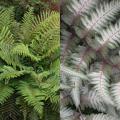Please read: This is the only plant that we sell that has an expected loss rate (with every other plant that we sell you should not lose a single plant). It is NOT recommended for anyone who is not experienced with this challenging fern. If you plant it properly, give it a suitable environment, and keep it adequately moist, 25% of these plants will not emerge after transplanting. If your environment and/or care is less than ideal, you could lose ALL of the plants. If you are not willing to assume this riak, do not order these plants. We will not replace or refund any plants that do not survive.
FYI: Tops that are on these when we ship will die back. They will later send up new tops. If they have no tops when we ship they will sometimes send up tops just to die back and send up new tops later. This is odd behaviour, but that is what happens.
Make sure you look at an example of a bare root Hayscented fern so you are not shocked by the "hairy sticks" you will receive.
IMPORTANT: Be sure to plant these roots parallel to the ground (do not plant them with the root pointing up/down, the root should be pointing side-to-side), about 1 inch below the surface of the soil.
Note: do not worry if they shoot up tops and then die back, that can happen and is not a cause for concern. New foliage will appear later. | |
Unique and prized for its delightful fragrance of freshly mown hay when crushed or bruised, Dennstaedtia punctilobula is a fantastic perennial groundcover for those with a large, blank canvas looking for economic and
moderate to
fast coverage. Light green fans of foliage turn golden in autumn brightening shaded gardens with soft luminescence. Intricate
bipinnate fronds create texture and movement.
Hay-scented Fern is tolerant of most soil types provided it is somewhat acidic, will grow in
full shade,
part sun and even
full sun (just give her regular moisture without leaving her feet wet), and absolutely adores a dappled shade environment. She is appreciated by gardeners for her willingness to
tolerate drought in shaded spots and harsh urban elements in city locales as well as the fact that
deer and
rabbits tend to avoid her.
Reaching heights of nearly 3 feet, this fern behaves beautifully as a taller
border edging, performs famously on a shaded slope
controlling erosion, and rapidly
naturalizes in woodland settings by underground
rhizomes. In mass plantings, which is hands-down the best application due to her slightly invasive personality, Hay-scented fern becomes a softly glowing thicket of lush green foliage that arches gracefully toward the light.
Please read about bare root plants so you know what to expect.
Interesting Facts The clusters of
sporangia are surrounded by cup-shaped coverings, hence the sometimes used common name of cup fern for plants in the genus Dennstaedtia.
This genus honors A. W. Dennstaedt, an 18th century German botanist.
Gardener Tips In hot, southern climates, Hay-scented Fern's foliage tends to go dormant in summer, so you will want to consider a companion plant with a late bloom time,
evergreen or richly colored foliage. If you need a border, try a row of Hay-scented Fern with a
Coral Bell such as Amethyst Mist whose deep burgundy foliage provides a gorgeous contrast.
Performs best in well-drained (but moist) soil with added organic compost or peat moss. Best not to allow soil to dry out.
Will tolerate sun if given enough moisture.
Ferns have delicate foliage that often suffers during shipment and transplanting. Cut off any foliage that is broken, bent, brown or yellow - the plants will quickly recuperate with fresh growth. Bare root ferns are particularly prone to foliage loss, it is not uncommon to have to cut them off at ground level when transplanting. As long as the roots are firm they will recover, often showing new growth within weeks during warm months. If transplanting bare root ferns during warm weather they might not send up foliage until summer ends or the following spring (best to transplant bare root ferns when they are dormant: late fall to early spring).
General information that applies to all plants:
-
Ground
preparation, fertilization, pH
-
Planting
instructions
-
Explanation
and description of bare roots
-
How
to plant bare root plants
-
If you
cannot plant bare roots right away
 (0)
(0) Full sun
Full sun  Part sun
Part sun  Shade
Shade




